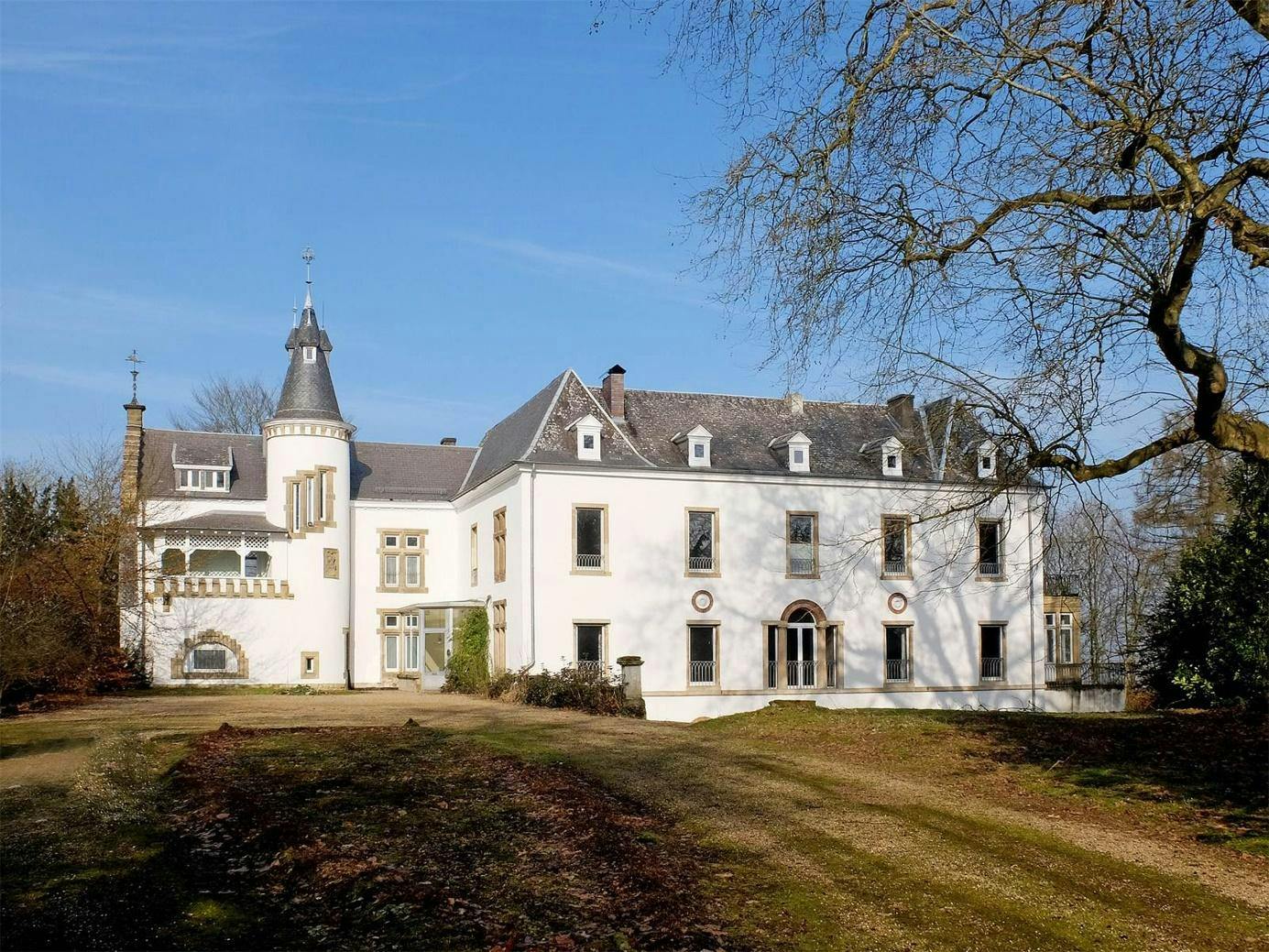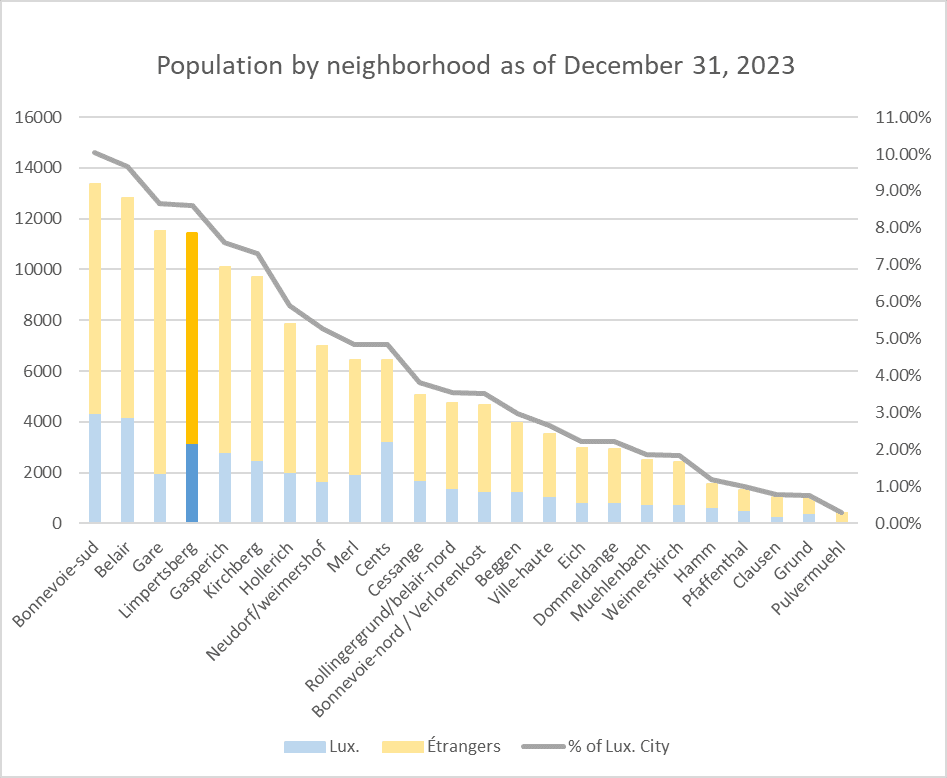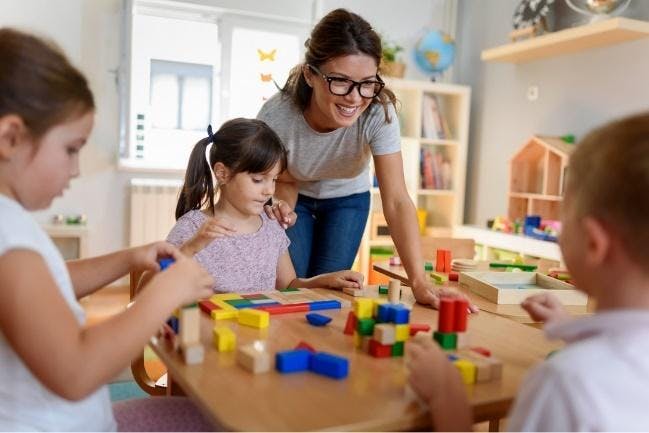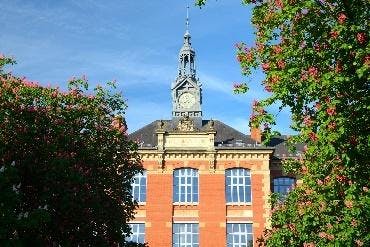
Limpertsberg: an elegant residential neighborhood in Luxembourg City
In the upcoming exploration of Limpertsberg, we get into its rich history, examine the dynamic population, weigh the pros and cons of calling this neighborhood home, assess transport accessibility, explore the communal infrastructure, and provide insights into renting and buying real estate.
Nestled just north of the city center, Limpertsberg stands as a captivating neighborhood in Luxembourg. Bordered by Mühlenbach and Eich to the north, Ville-Haute to the south, and Rollingergrund/Belair-Nord to the west, this locale boasts an elegant and traditional architectural style. Its allure lies in the proximity to the city center and the bustling Kirchberg business district, making it a sought-after residential haven.
General characteristics of Limpertsberg
This neighborhood presents an enticing blend of charming residences and a thriving community. Families are drawn to the area's high concentration of schools, although some have relocated or are planning to do it to alleviate traffic concerns. Beyond its primarily residential nature, Limpertsberg is a mixed-use neighborhood, offering an array of local shops, bars, restaurants, and various service-oriented businesses.
Dotted with green spaces such as Tony Neuman Park and the park on Georges Willmar Street, Limpertsberg provides residents with serene surroundings. Additionally, its proximity to the expansive Kinnekswiss Park adds to the neighborhood's appeal. It's no wonder that Limpertsberg stands as one of the city's most attractive and populous districts.
Population of the neighborhood
Encompassing 157.07 hectares with a population density of 72.7 individuals per hectare, the neighborhood stands out as one of the most densely populated in both absolute numbers and population density.

With 72.44% of its residents being foreigners it closely aligns with the citywide average of 70.44%.
Transport accessibility
Effortless mobility is woven into the fabric of Limpertsberg, providing residents with a seamless array of transportation options. From swift car commutes to an extensive bus network, tram accessibility, bike-friendly avenues, and pedestrian-friendly pathways, the neighborhood caters to diverse preferences.





You can check the route of each bus line in detail on the interactive map provided by the city of Luxembourg and get detailed instructions to get from one point to another on their route planner page.
Renting and buying real estate
With high demand driving the real estate market in Limpertsberg, prices reflect the sought-after nature of the neighborhood. Purchase prices stand at 12,559 euros/m², slightly above the capital's average.
Rental prices are equally elevated at 30.64 euros/m², following the city's average of 30.72 euros/m². This cost is easy to explain with the prime location, nestled next to the capital's center and in proximity to the Kirchberg business district, which makes it a highly sought-after residential haven.
For purchase prices stand at
For renting prices stand at
Applications, search and profound advice in our guide to rent in Luxembourg

Infrastructure of the neighborhood
Limpertsberg stands as a testament to urban living at its finest, offering a spectrum of amenities that make it undeniably attractive. Renowned for its educational infrastructure, the neighborhood hosts numerous secondary schools and proudly accommodates one of the campuses of the University of Luxembourg. Beyond education, Limpertsberg unfolds a vibrant panorama featuring cultural venues like the Grand Théâtre de Luxembourg, versatile sports facilities in the Centre Sportif Tramsschapp, and lush green retreats such as Tony Neuman Park. In essence, Limpertsberg encapsulates the essence of a self-sufficient and thriving urban community.
If you're considering making Luxembourg your new home, we encourage you to explore our range of articles that look in depth at the different city communes and neighborhoods.
Pros and cons of living in Limpertsberg
Limpertsberg presents itself as an almost idyllic neighborhood, offering a myriad of advantages. The neighborhood ensures seamless connectivity to the rest of the city, boasting access to major thoroughfares, an extensive bus network, and tram accessibility. Beyond its strategic location, Limpertsberg flourishes with local amenities, featuring a diverse array of shops, bars, restaurants, and a plethora of service-oriented businesses. The neighborhood doesn't compromise on green spaces, with numerous parks enhancing the quality of life.
However, the neighborhood's desirability becomes a double-edged sword. The high demand for housing has significantly driven up property prices, both in terms of purchase and rental, making Limpertsberg one of the priciest areas in the capital. Despite this drawback, the neighborhood's myriad advantages continue to make it a favorite among residents.
What can you find in this neighborhood of Luxembourg City
Infrastructure-wise, Limpertsberg shines in education, providing a spectrum of secondary schools and contributing to higher education through the presence of a campus of the Université de Luxembourg. The neighborhood doesn't compromise on green spaces either, with numerous parks enhancing the quality of life. Many shops, restaurants and bars will suffice every taste of leisure activity.
Preschool and elementary education
The neighborhood houses the Limpertsberg Public School, complemented by two public childcare centers, Limpertsberg Ermesinde and Limpertsberg Henri VII, the latter with two locations. Numerous daycare options include notable ones like Day Care Arcus, BioBébé, Barbara with two branches, and the Rockids daycare network boasting three locations in Limpertsberg.
Secondary education
Renowned for its abundance of secondary schools, Limpertsberg hosts institutions such as Lycée Michel Lucius Luxembourg, Lycée technique du Centre, Lycée de Garçons de Luxembourg, Lycée des Arts et Métiers, and Lycée Robert-Schuman Luxembourg, among others. The extensive offering led to traffic challenges in the neighborhood, prompting some secondary schools to relocate.
Notably, Lycée Michel Lucius is set to move to "op der Schleed" in Kirchberg by 2028.
Higher education
University of Luxembourg: Address: 162a Av. de la Faiencerie, Phone: (+352) 46 66 44 60 00, Website: uni.lu
In addition to primary and secondary schools, Limpertsberg is fortunate to host one of the campuses of the University of Luxembourg. Established on August 12, 2003, this public university is the sole one in the Grand Duchy of Luxembourg. Boasting a diverse student body of around 6,800 from approximately 130 countries, the faculty comprises 283 professors, assistant professors, and lecturers from 20 different nations.
The university offers a wide array of academic programs, including 11 bachelor's and 23 master's degrees spread across three faculties and three campuses. The Limpertsberg campus houses the Faculty of Law, Economics and Finance, the Faculty of Science, Technology and Medicine, and the Department of Physics and Material Science.
Limpertsberg offers a rich cultural landscape, boasting prominent venues such as the Grand Théâtre de Luxembourg, two concert halls, and a cinema.
Theatre
Concert Halls and Events
Cinemas
Learn more about Luxembourg's culture and traditions in our special guide.
Limpertsberg offers specialized healthcare through clinics like the Groupe Médical Pasteur, founded in 2014 by Dr. Jean-Marc CHARLES, and directed by Nathalie CHARLES HERBER. Spanning 400 m², this medical center brings together professionals in various fields, from dentistry and angiology to aesthetic medicine. Additionally, the Clinique Liberté specializes in aesthetic medicine and hair transplants.
For broader medical needs requiring hospital facilities, residents can easily access nearby hospitals, with the Centre Hospitalier de Luxembourg being the largest healthcare center in the city. While Limpertsberg may not host hospitals within its borders, its proximity to key healthcare institutions ensures residents have swift access to comprehensive medical services.
Limpertsberg is adorned with a delightful array of green spaces, offering residents serene escapes and recreational opportunities.
Limpertsberg's sports infrastructure caters to a wide range of interests, offering everything from a multi-sports hall to tennis courts and fitness facilities.
The Centre Sportif Tramsschapp, situated on the site of former tram and bus municipal depots, now stands as a versatile sports and cultural center. This expansive venue accommodates various sporting disciplines, providing ample space for diverse activities.
Two dedicated gyms further enhance the fitness landscape. FitNest Luxembourg, an exclusive and personalized fitness center, operates strictly by appointment. Private sessions, overseen by certified trainers, tailor workout programs based on individual goals and needs. The U‘Fit Club, the second gym, offers a diverse range of classes, including boxing, dance, and general fitness.
For tennis enthusiasts, two municipal tennis courts complete the sports ensemble, ensuring that residents in Limpertsberg have access to a well-rounded and comprehensive array of sports facilities.
Limpertsberg boasts diverse shops, numerous restaurants, and convenient supermarkets for grocery shopping. Standouts include Cactus Marché on Avenue Pasteur and Monop'Pasteur right across, ensuring residents have a variety of options at their fingertips.
Historical overview
The etymology of Limpertsberg is shrouded in mystery, with one prevalent theory linking its name to Mont-Saint-Lampert. However, alternative theories persist, given the absence of the name on historical maps and documents. The district's nomenclature has undergone transformations, evolving from Lamperbierg to Lamper and eventually settling on Limpertsberg.
Medieval era
XIX century
Modern history

Frequently Asked Questions (FAQ)
What makes Limpertsberg a desirable residential neighborhood?
Limpertsberg's allure lies in its perfect blend of urban and green living. Proximity to the city center, a robust educational infrastructure, cultural venues, and lush parks like Tony Neuman and Kinnekswiss make it an ideal locale for families and professionals seeking a vibrant yet serene living experience.
Are there parks and recreational areas in Limpertsberg?
Yes, Limpertsberg offers residents ample green spaces, including Tony Neuman and Kinnekswiss parks. These areas provide not only serene retreats but also opportunities for outdoor activities and relaxation.
How is the real estate market in Limpertsberg?
The real estate market in Limpertsberg is dynamic, reflecting its high demand. Purchase prices at €12,559/m² and rental rates at €30.64/m², slightly exceeding the city's average, signify the neighborhood's popularity and competitive market.
What educational facilities are available in Limpertsberg?
Limpertsberg is renowned for its educational excellence, hosting numerous secondary schools and the University of Luxembourg campus. The neighborhood's educational infrastructure makes it an attractive choice for families.
How is the transport accessibility in Limpertsberg?
Limpertsberg boasts excellent transport connectivity, with easy access to the city center and Kirchberg. Whether by car, bus, tram, bicycle or on foot, residents enjoy convenient and efficient travel options, enhancing the neighborhood's accessibility and connectivity.
Source: fr.wikipedia.org, en.wikipedia.org, www.justarrived.lu, infos.rtl.lu, www.uni.lu, fr.wikipedia.org, www.luxembourg-city.com, www.luxembourg-city.com, ufit.lu, www.fitnest.lu, www.immotop.lu
We took photos from these sources: Gabor Koszegni for Unsplash, Kids'ville Facebook Page, vdl.lu, Spillplaz, Google Maps



